|
|
General
The term “colloidal matter” characterizes a
class of materials consisting of large assemblies of colloidal particles. As
the individual particles are substantially larger than the atomic scale but
still much smaller than a macroscopic size, these materials have unusual
thermodynamic, rheological and optical properties bridging the gap between the
molecular and macroscopic world. This makes colloidal matter interesting, both
from the fundamental and applied point of view. In addition, the size of the
building blocks makes these materials amenable to relatively simple chemical
modifications, allows for quantitative 3D analysis with confocal microscopy and
makes it possible to manipulate the structures with external fields. Computer
simulations on the same systems that are studied experimentally in real-space
provide a powerful combination to increase our understanding of these (soft)
condensed matter model systems. Our fundamental work focuses on using colloids
as a way to extend our knowledge of condensed matter problems like,
freezing/melting, the glass transition. Our interest in more applied use of
soft condensed matter focuses on photonics.
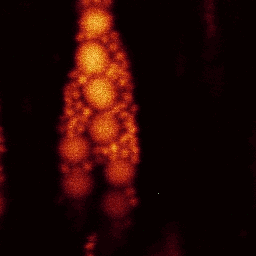
Colloidal Model Systems
Using chemical synthesis techniques a variety of colloidal core-shell particles
can be prepared. For fluorescence confocal microscopy the core consists of a
fluorescently labeled material, while the shell consists of a non-fluorescent
material like pure silica. In this case the core enables the confocal detection
while the larger shell makes it possible to detect even touching spheres and
to chemically modify the surface. Most of the syntheses and characterization
are done at the Van ‘t Hoff Laboratory of the Debye Institute (Utrecht University).
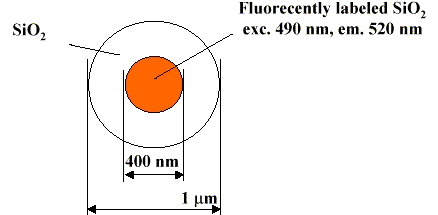 |
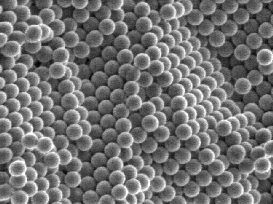 |
|
Schematic picture
of fluorescent core-silica shell
particle used for confocal microscopy
|
SEM
picture of fluorescent core-silica shell particle used for confocal microscopy |
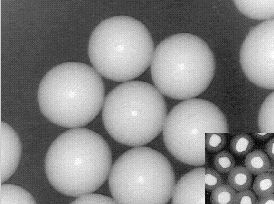 |
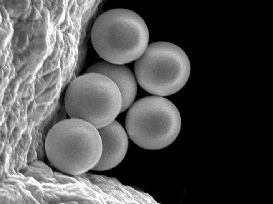 |
|
TEM picture of silica
particles with a gold core
(gold radius 15 nm, total 150 nm)
|
SEM picture of a high refractive index ZnS-cores (radius 1.6 mm) |
Different core-shell morphologies
give the particles different specific properties suited for various applications:
optical tweezers, photonic crystals, ER fluids
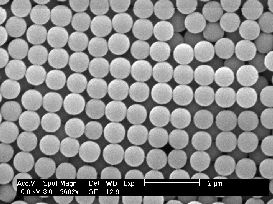 |
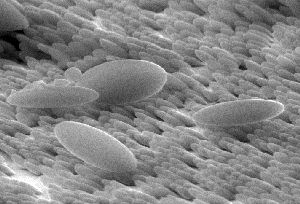 |
Fluorescent-silica
(200 nm radius)-core PMMA-
shell colloid (final radius 600 nm). These
spheres can be index and density matched. |
Ellipsoidal
silica spheres (original size 300 nm and 1000 nm) made by ion beam irradiation
(together with the group of Albert Polman, AMOLF) |
Experimental Techniques
Confocal Microscopy
In confocal microscopy a
pinhole is used in the focal plane both at illumination and at detection. In
this way out of focus emitted light is effectively rejected by the detection
pinhole and an increased resolution is obtained (top left). By scanning through the focal
plane an image of a slice inside the sample can be taken (top right). From several
slices taken at different heights a 3D-image of the sample can be reconstructed
(bottom left) and particle coordinates can be obtained (right). A 3D
reconstruction of a colloidal liquid-crystal interface is shown (bottom right).
Computer Simulations (Marjolein Dijkstra)
Projects
Condensation of Charged Spheres and Swelling of
Clay Platelets (01PR1983: Antti-Pekka Hynninen)
The explanation of the experimentally observed phenomena of (i) attraction
between like-charged colloidal spheres and (ii) the sol-gel transition
in clay suspensions are two of the most profound problems in colloid science.
We propose to study both phenomena by simulation using the classical
analogue of the Car-Parinello method. In this recently introduced
method the mesoscopic (colloidal) particles are treated explicitly by
Molecular Dynamics simulation, whereas the microions are treated on the
level of their density profiles that
follow from minimising the free energy functional. We plan to extend this
novel
method to systems coupled to a salt-reservoir, and to combine it with standard
techniques for determining phase equilibria, such as the Gibbs Ensemble method
and thermodynamic integration. This combination of extensions allows us to
determine the phase diagram and the structure of suspensions of colloidal
spheres and clay particles, not only in the well-understood regime of high
salt concentrations, but also in the low-salt regime, where the unexplained
phenomena (i) and (ii) were observed.
Colloidal Rods at Interfaces (UU: Svyatoslav Savenko)
In this project we plan to study suspensions of
rodlike particles in contact with a planar hard wall in which rodlike
particles are embedded parallel to the wall. In order to investigate the
wetting behaviour,
we recently developed a new Monte-Carlo method for
simulating fluids in contact with a single wall.
In this method, we simulate the suspension in contact with a single wall,
while a flat density profile is imposed far from this wall using a penalty
function that suppresses large density fluctuations from a self-consistently
determined averaged bulk density. In this way, we can avoid simulations with
two walls, which can induce capillary
condensation/nematization.
Using this technique, we were indeed able to follow the logarithmic growth
of a thick nematic film at the wall-isotropic interface (see figure on the
cover page). We propose to
investigate the interfacial behaviour of hard-rod fluids in contact with
corrugated walls by extending this technique to structured walls. We hope
that our simulations can give some insight in the
origin of the alignment effects of LC molecules on corrugated/rubbed surfaces.
Entropic Wetting in Colloidal Mixtures (01SFFSM22: Andrea Fortini)
The focus of this proposal is on two different systems where the bare interactions are either hard o
r ideal: (i) a simple model for a mixture of colloids and ideal polymer and (ii) a mixture of thin a
nd thick rod-like particles.
Our group has a proven track record in the determination of the bulk phase
behaviour of both systems with theory and simulations, which gives us an excellent position to study
the wetting behaviour. For both systems, we plan to
investigate how the topology of the phase diagram influences the location of
wetting transitions.
Colloidal Epitaxy
Colloidal epitaxy provides a means to direct the growth of colloidal crystals.
Under the influence of gravity colloids settle at the bottom of the container,
forming close packed crystalline domains. By using a corrugated wall where the
pattern of holes equals a well chosen crystal plane, a colloidal crystal can be
grown epitaxially. In this way an almost perfect face centered cubic crystal of
hard-sphere like silica particles was grown. At the moment we are trying to grow
a hexagonal close packed crystal, which, for hard spheres, has a slightly higher
free energy.
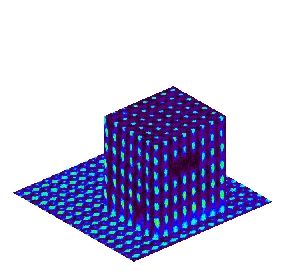 |
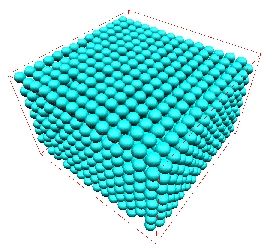 |
| View cut
out of a 3D-stack of confocal microscopy images of a crystal grown on a
fcc (100)-template |
Computer-generated
reconstruction of the coordinates obtained from this dataset. |
| Confocal microscopy
images of two fcc (100)-template with different lattice constants |
 |
In
the intermediate (unpatterned) region a reconstruction to a hexagonal structure
can be seen. |
 |
When
the distance between the patterned regions is decreased, the (100)-structure
extends over the unpatterned region. |
Manipulation of colloidal
crystal growth has applications for the production of photonic crystals. Understanding
the dynamics of epitaxial crystal growth is on the other hand an interesting
and fundamental research question. Even the role of gravity in the epitaxial
growth process, which is not yet understood, can be examined by using particles
that can be density matched with their suspending liquid.
Inverse Photonic Crystals (02POM10: J.H.J. Thijssen)
|
Photonic crystals are 3D structures in which the refractive index varies periodically throughout space. Such structures form
a periodic potential for photons, causing strong interactions with light. In a way, these interactions can be considered as
Bragg-reflections. Provided the refractive index contrast is large enough and a suitable structure is chosen, photonic
crystals can exhibit a photonic band gap. This means that light of a certain frequency range cannot propagate within the
crystal in any direction regardless of its polarization. In other words, light of a frequency within the gap will be
Bragg-reflected such that standing waves are formed in all directions for all polarizations. Thus, a photonic band gap is the
optical analogue of an electronic band gap in semiconductors. However, since Maxwell's equations are scale-invariant, a
structure can be designed to have a band gap at any desired wavelength. For example, if the gap is tuned at a wavelength of
1.3 or 1.5 micron, photonic crystals could be used in fibres for longe-distance telecommunication.
|
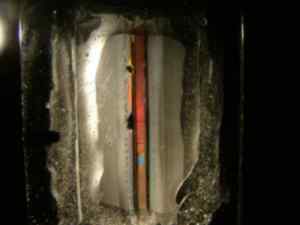
White-light-illumination image of Bragg colors produced by a photonic crystal of 1.4 micron diameter silica spheres.
|
|
One way of fabricating photonic crystals is by colloidal self-assembly. Colloids are particles with sizes on the order of
1 nm up to 1 micron. These colloidal particles could be ideal building blocks for photonic crystals, for they feature sizes
on the order of visible and near-infrared light, and they are known to self-assemble under the right conditions. Furthermore,
the single particle properties of colloids can be chemically modified. Regular structures of colloids are called colloidal
crystals and if the refractive index of the colloids is different from that of the host, which is almost always the case,
these crystals are photonic crystals, by definition.
In our group, two routes towards photonic crystals are explored. One of them uses monodisperse colloidal silica
spheres to form colloidal crystals that serve as a template. The spheres are usually labelled with a fluorescent dye, which
allows individual imaging of touching particles using confocal microscopy. Other characterisation techniques that are used
include laser diffraction, x-ray diffraction (see figure), Vis-NIR spectroscopy and electron microscopy.
|
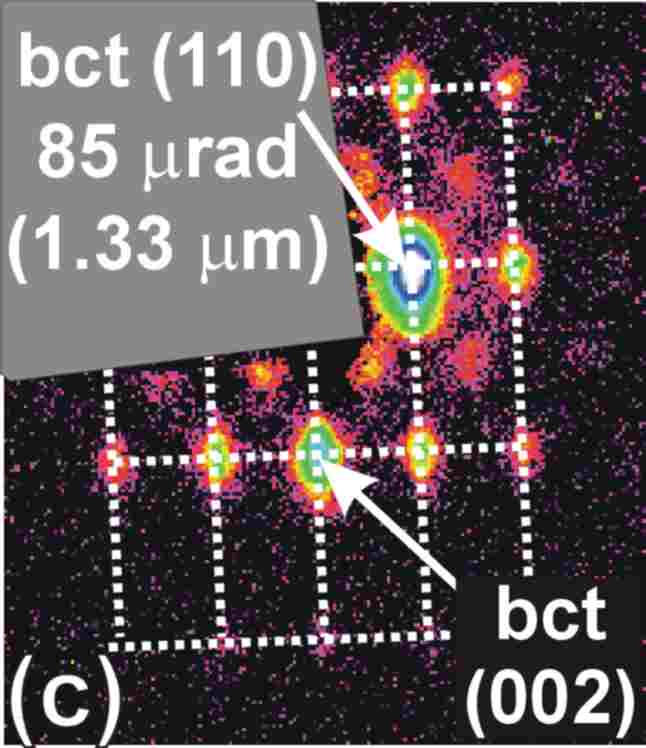
X-ray diffraction image of an inverted bct crystal of 1.4 micron diameter silica spheres.
|
|
With a little bit of effort, it is possible to grow face-centred cubic (fcc) colloidal crystals by sedimentation of
monodisperse colloidal spheres. It has been calculated that an fcc crystal of air-spheres in silicon has a band gap with a
relative width of 5%. However, this gap is not very robust and its width is not spectecular. For example, a diamond crystal of
air spheres in silicon exhibits a much larger and much more robust gap at a much lower index contrast However, up till now,
nobody has succeeded in fabricating a photonic crystal with diamond symmetry and a sufficient index contrast.
In our group, we try to grow colloidal crystals with symmetries other
than the fcc one as well. For example, sedimentation of highly charged
spheres with a long-range interaction yields a body-centred cubic (bcc)
crystal. Sedimentation in an electric field perpendicular to gravity yields
crystals with body-centred tetragonal (bct) or face-centred orthorhombic (fco)
symmetry, depending on the charge of the colloids. For example, the figure shows
a confocal microscope images of the bct hexagonal (110) plane; the lower figure is
a side-view ((100) plane), clearly showing bct AB-stacking. In this way,
using external fields to influence the crystallization of colloidal
particles, it might be possible in the future to obtain even more different
structures.
|
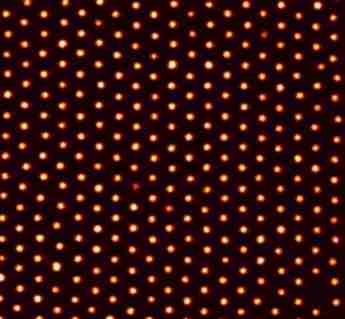
Confocal xy-scan ((110)-plane) of a bct crystal of 1.4 micron diameter silica spheres.
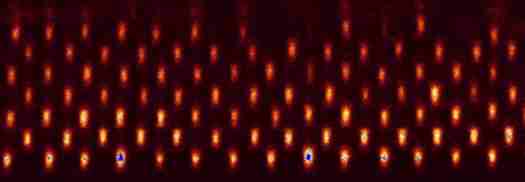
Confocal xz-scan ((100)-plane) of the same crystal.
|
|
Usually, silica colloids are used for fabricating colloidal crystals. The refractive index of silica equals 1.45 (compare
1.33 for water and 1.5 for glass). If air is the host medium, the index contrast of such a silica colloidal crystal is 1.45,
which is too low to open up a band gap. Thus, in a final step, the colloidal crystal is used as a template for
infiltration using chemical vapor deposition (CVD). The colloidal crystal is infiltrated with a high-index material, such as
silicon (see figure). Silicon has the advantage that it has a large refractive index (3.5) and absorption is small for wavelengths
larger than 1.1 micron. Furthermore, silicon photonic crystals should be compatible with existing technologies from the
semiconductor industry. In a last step, the original silica template is removed by wet etching, enlarging the index contrast
(from 2.41 to 3.5).
|
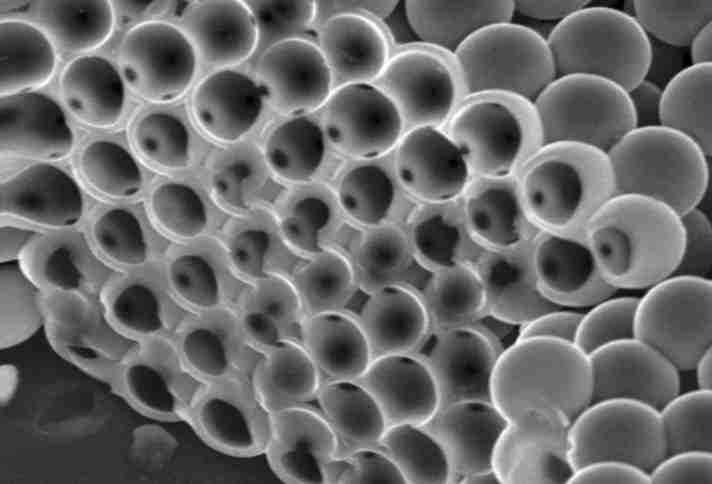
Scanning Electron Microscope image of an fcc air-sphere crystal in a backbone of silicon (image by D.C. 't Hart).
|
Electro-Rheological Fluids
When a dispersion of uncharged colloidal spheres is placed in a (uniform)
electric field the dielectric constant difference between particles and solvent
creates dipolar interaction potentials between the spheres. If the fields are
so high that the dipolar interactions between the spheres are several times
kT non-equilibrium string-like structures are formed spanning the container
and the dispersion starts behaving like a solid. This ability to change viscosity
over several orders of magnitude in milliseconds is useful for applications
like shock absorbers or a variable transmission. The proposed lowest energy
structure for monodisperse spheres at high fields is a body centered tetragonal
crystal (BCT). At relatively low fields (~0.5 V/mm), where interaction forces
between the spheres were only several times kT, we observed such BCT
crystals (figure on the right). Furthermore, intriguing metastable sheet-like
structures, not yet predicted by theory, were seen as precursor to the BCT crystals
(left three Figures). At higher concentrations, where the equilibrium phase
without field is an FCC colloidal crystal, an interesting martensitic FCC-BCT
transition was found.
Particles 1 micron diameter,
fluorescent core 400 nm.Confocal micrographs, field strength: ~0.5 V/mm.
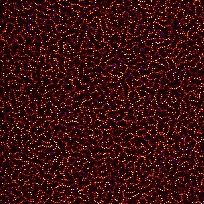 |
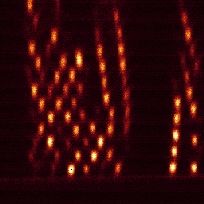 |
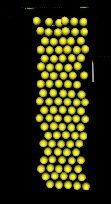 |
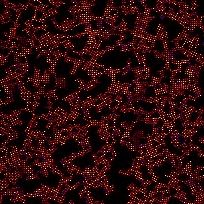 |
ER
fluids time sequence showing sheets (perpendicular to the field and along
the field). Finally BCT crystals form (last image inset is enlarged, field
perpendicular). |
| |
|
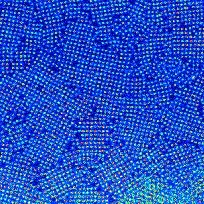 |
FCC-BCT
crystal transition |
Optical Tweezers
Metallo-Dielectric Colloids
Binary Colloids
Monodisperse Anisotronic Colloids
Real-Space Analysis of Sedimentation
Coating Monodisperse Emulsions
Equipment
|